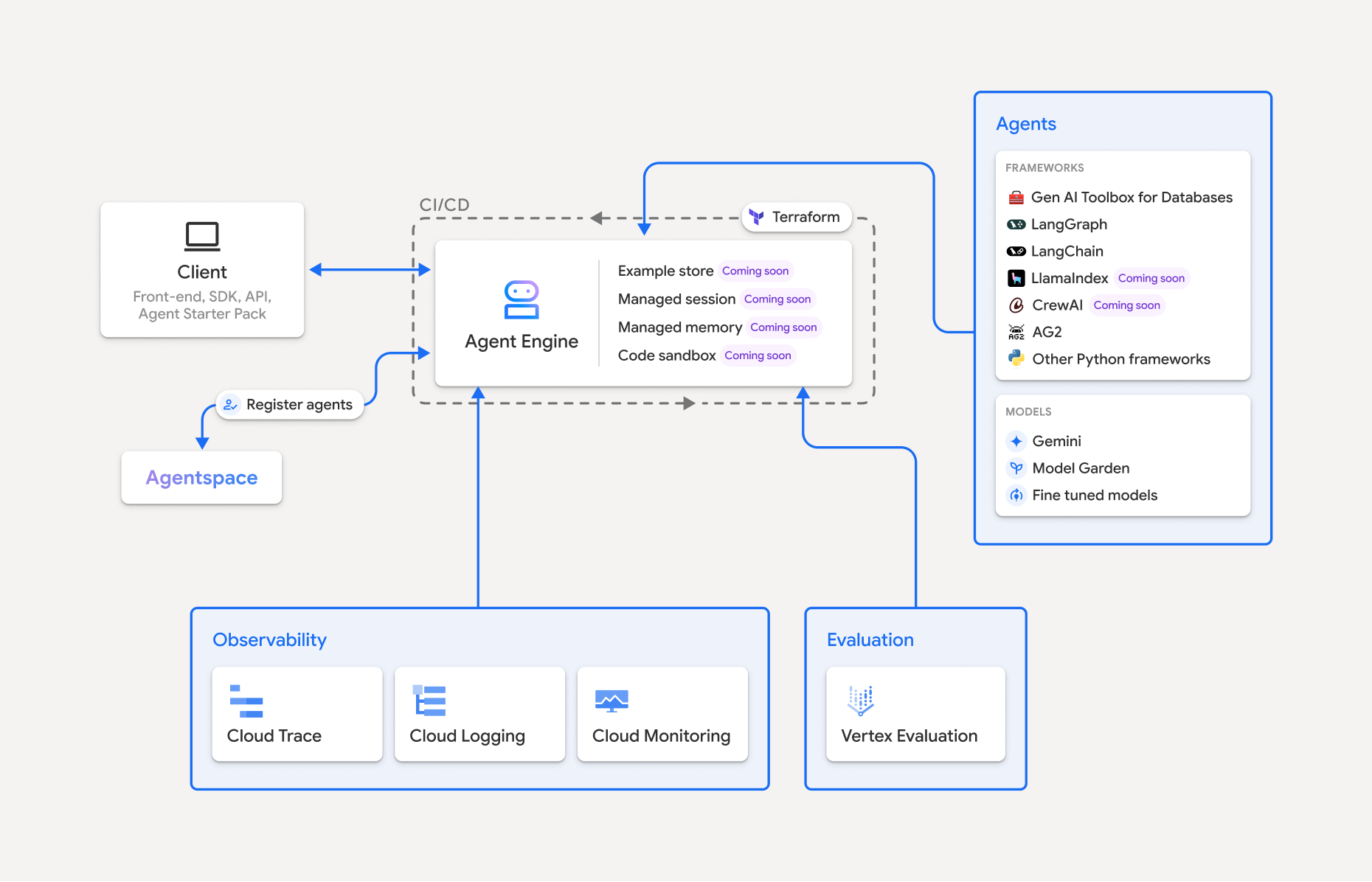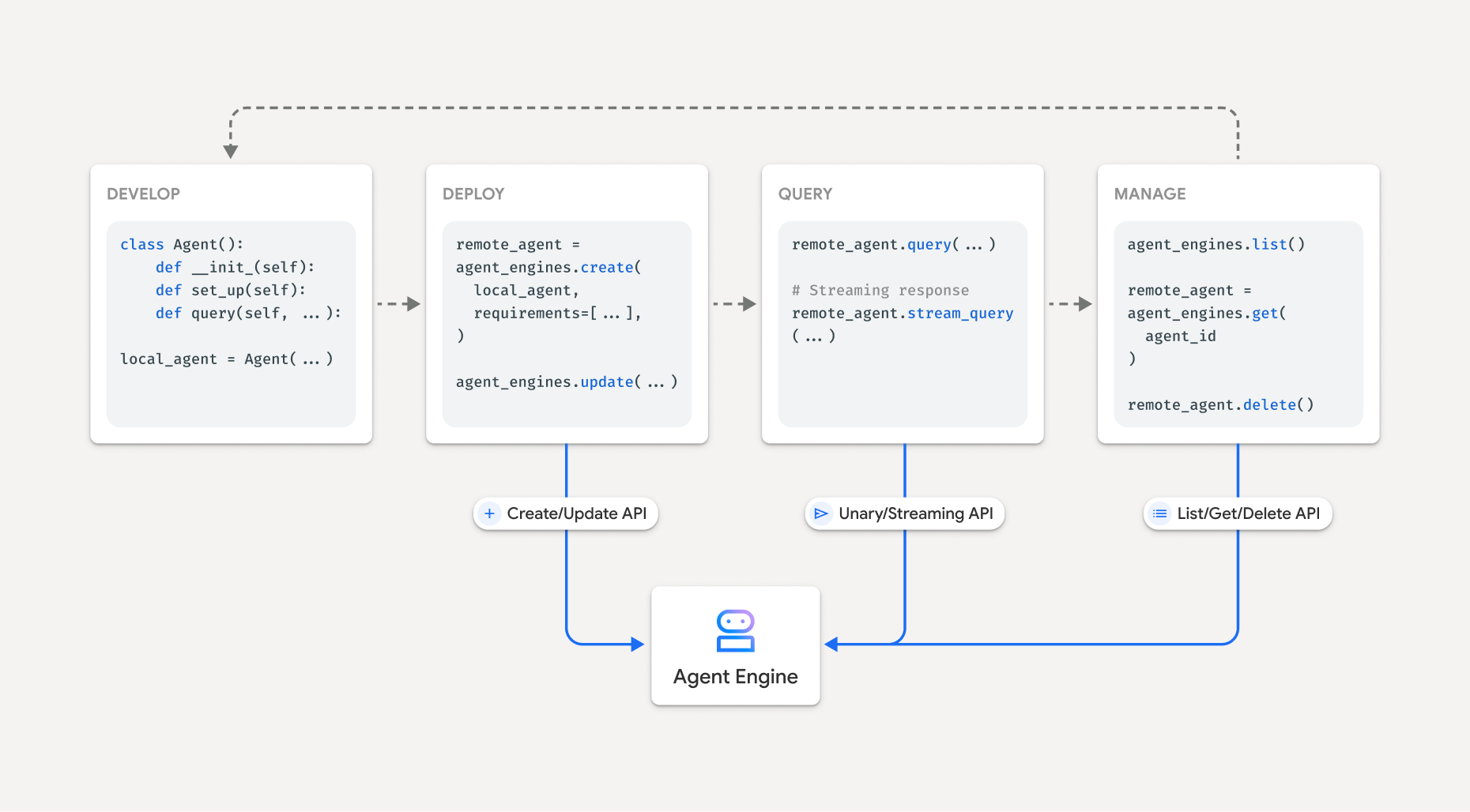Vertex AI Platform の一部である Vertex AI Agent Engine は、開発者が本番環境で AI エージェントをデプロイ、管理、スケーリングできるようにする一連のサービスです。本番環境でエージェントをスケーリングするためのインフラストラクチャの処理は Agent Engine が行うため、開発者はアプリケーションの作成に集中できます。Vertex AI Agent Engine で提供されるサービスは次のとおりです。これらは、個別に使用することも組み合わせて使用することもできます。
ランタイム:
- マネージド ランタイムとエンドツーエンドの管理機能を使用して、エージェントをデプロイしてスケーリングします。
- システム依存関係のビルド時のインストール スクリプトを使用して、エージェントのコンテナ イメージをカスタマイズします。
- VPC-SC コンプライアンスや認証と IAM の設定などのセキュリティ機能を使用します。
- 関数呼び出しなどのモデルやツールにアクセスします。
- さまざまな Python フレームワークと Agent2Agent オープン プロトコルを使用して構築されたエージェントをデプロイします。
- Google Cloud Trace(OpenTelemetry をサポート)、Cloud Monitoring、Cloud Logging を使用して、エージェントの動作を把握します。
品質と評価(プレビュー): 統合された Gen AI Evaluation Service でエージェントの品質を評価し、Gemini モデルのトレーニング実行でエージェントを最適化します。
Example Store(プレビュー): 少数ショットの例を保存して動的に取得し、エージェントのパフォーマンスを改善します。
Sessions(プレビュー): Agent Engine Sessions を使用すると、ユーザーとエージェントの間の個々のインタラクションを保存し、会話のコンテキストの明確なソースを提供できます。
Memory Bank(プレビュー): Agent Engine Memory Bank を使用すると、セッションから情報を保存して取得し、エージェントのインタラクションをパーソナライズできます。
Code Execution(プレビュー): Agent Engine Code Execution を使用すると、エージェントは隔離された安全なマネージド サンドボックス環境でコードを実行できます。

Vertex AI Agent Engine は、AI エージェントの検出、構築、デプロイを行うための機能スイートである Vertex AI Agent Builder の一部です。
Vertex AI Agent Engine で作成してデプロイする
注: Vertex AI Agent Engine での合理化された IDE ベースの開発とデプロイのエクスペリエンスについては、agent-starter-pack をご覧ください。すぐに使用できるテンプレートと試験運用のための組み込みの UI が用意されており、デプロイ、運用、評価、カスタマイズ、オブザーバビリティが簡素化されます。
Vertex AI Agent Engine でエージェントを構築するワークフローは次のとおりです。
| ステップ | 説明 |
|---|---|
| 1. 環境を設定する | Google プロジェクトを設定し、最新バージョンの Vertex AI SDK for Python をインストールします。 |
| 2. エージェントを開発する | Vertex AI Agent Engine にデプロイできるエージェントを開発します。 |
| 3. エージェントをデプロイする | エージェントを Vertex AI Agent Engine マネージド ランタイムにデプロイします。 |
| 4. エージェントを使用する | API リクエストを送信してエージェントをクエリします。 |
| 5. デプロイされたエージェントを管理する | Vertex AI Agent Engine にデプロイしたエージェントを管理、削除します。 |
次の図は、このプロセスを示しています。

サポートされているフレームワーク
次の表に、各種のエージェント フレームワークに対して Vertex AI Agent Engine が提供するサポートレベルを示します。
| サポートレベル | エージェント フレームワーク |
|---|---|
| カスタム テンプレート: カスタム テンプレートを適応させて、フレームワークから Vertex AI Agent Engine へのデプロイをサポートできます。 | CrewAI、カスタム フレームワーク |
| Vertex AI SDK の統合: Vertex AI Agent Engine は、Vertex AI SDK とドキュメントでフレームワークごとにマネージド テンプレートを提供します。 | AG2、LlamaIndex |
| 完全な統合: フレームワーク、Vertex AI Agent Engine、より広範な Google Cloud エコシステム全体で機能するように統合されています。 | Agent Development Kit(ADK)、LangChain、LangGraph |
Agent Starter Pack を使用して本番環境にデプロイする
Agent Starter Pack は、Vertex AI Agent Engine 用に構築された本番環境対応の生成 AI エージェント テンプレートのコレクションです。Agent Starter Pack には次のものが含まれています。
- 事前構築済みのエージェント テンプレート: ReAct、RAG、マルチエージェントなどのテンプレート。
- インタラクティブなプレイグラウンド: エージェントをテストして操作します。
- 自動化されたインフラストラクチャ: リソース管理の合理化のために Terraform を使用しています。
- CI / CD パイプライン: Cloud Build を活用した自動デプロイ ワークフロー。
- オブザーバビリティ: Cloud Trace と Cloud Logging の組み込みのサポート。
利用を開始するには、クイックスタートをご覧ください。
ユースケース
エンドツーエンドの例を使用して Vertex AI Agent Engine の詳細を確認するには、次のリソースをご覧ください。
エンタープライズ セキュリティ
Vertex AI Agent Engine は、企業のセキュリティ要件を満たし、組織のセキュリティ ポリシーを遵守し、セキュリティのベスト プラクティスに従うのに役立つ機能をいくつかサポートしています。次の機能がサポートされています。
VPC Service Controls: Vertex AI Agent Engine は、データ セキュリティを強化し、データの引き出しのリスクを軽減するために、VPC Service Controls をサポートしています。VPC Service Controls が構成されている場合、デプロイされたエージェントは、BigQuery API、Cloud SQL Admin API、Vertex AI API などの Google API とサービスへの安全なアクセスを維持し、定義された境界内でのシームレスなオペレーションを確認します。VPC Service Controls は、すべての公共のインターネット アクセスを効果的にブロックし、データ移動を承認済みネットワーク境界内に制限することで、企業のセキュリティ ポスチャーを大幅に強化します。
Private Service Connect インターフェース: Vertex AI Agent Engine Runtime の場合、PSC-I を使用すると、エージェントはユーザーの VPC でプライベートにホストされているサービスとやり取りできます。詳細については、Vertex AI Agent Engine で Private Service Connect インターフェースを使用するをご覧ください。
顧客管理の暗号鍵(CMEK): Vertex AI Agent Engine は、独自の暗号鍵でデータを保護する CMEK をサポートしています。これにより、 Google Cloudで保存データを保護する鍵の所有権と完全な制御を保持できます。詳細については、Agent Engine CMEK をご覧ください。
データ所在地(DRZ): Vertex AI Agent Engine は、すべての保存データと使用中のデータが指定されたリージョン内に保存されるように、データ所在地(DRZ)をサポートしています。
HIPAA: Vertex AI Platform の一部として、Vertex AI Agent Engine は HIPAA ワークロードをサポートしています。
アクセスの透明性: アクセスの透明性では、コンテンツへのアクセス時に Google の担当者が行うアクションを記録したログが提供されます。Vertex AI Agent Engine でアクセスの透明性を有効にする方法については、Vertex AI のアクセスの透明性をご覧ください。
次の表に、各 Agent Engine サービスでサポートされているエンタープライズ セキュリティ機能を示します。
| セキュリティ機能 | ランタイム | セッション | Memory Bank | Example Store | コードを実行する |
|---|---|---|---|---|---|
| VPC Service Controls | はい | はい | はい | いいえ | いいえ |
| 顧客管理の暗号鍵 | はい | はい | はい | いいえ | いいえ |
| データ所在地(DRZ)の保存時 | はい | はい | はい | いいえ | いいえ |
| 使用中のデータ所在地(DRZ) | いいえ | ○ | ○* | いいえ | はい |
| HIPAA | はい | はい | はい | はい | いいえ |
| アクセスの透明性 | はい | はい | はい | いいえ | いいえ |
* Gemini リージョン エンドポイントを使用する場合のみ。
サポートされるリージョン
Vertex AI Agent Engine ランタイム、Agent Engine Sessions、Vertex AI Agent Engine Memory Bank は、次のリージョンでサポートされています。
| 地域 | ロケーション | サポート対象のバージョン |
|---|---|---|
us-central1 |
アイオワ | v1 が一般提供機能としてサポートされています。v1beta1 はプレビュー機能としてサポートされています。 |
us-east4 |
北バージニア | v1 が一般提供機能としてサポートされています。v1beta1 はプレビュー機能としてサポートされています。 |
us-west1 |
オレゴン | v1 が一般提供機能としてサポートされています。v1beta1 はプレビュー機能としてサポートされています。 |
europe-west1 |
ベルギー | v1 が一般提供機能としてサポートされています。v1beta1 はプレビュー機能としてサポートされています。 |
europe-west2 |
ロンドン | v1 が一般提供機能としてサポートされています。v1beta1 はプレビュー機能としてサポートされています。 |
europe-west3 |
フランクフルト | v1 が一般提供機能としてサポートされています。v1beta1 はプレビュー機能としてサポートされています。 |
europe-west4 |
オランダ | v1 が一般提供機能としてサポートされています。v1beta1 はプレビュー機能としてサポートされています。 |
europe-southwest1 |
マドリッド | v1 が一般提供機能としてサポートされています。v1beta1 はプレビュー機能としてサポートされています。 |
asia-east1 |
台湾 | v1 が一般提供機能としてサポートされています。v1beta1 はプレビュー機能としてサポートされています。 |
asia-northeast1 |
東京 | v1 が一般提供機能としてサポートされています。v1beta1 はプレビュー機能としてサポートされています。 |
asia-south1 |
ムンバイ | v1 が一般提供機能としてサポートされています。v1beta1 はプレビュー機能としてサポートされています。 |
asia-southeast1 |
シンガポール | v1 が一般提供機能としてサポートされています。v1beta1 はプレビュー機能としてサポートされています。 |
australia-southeast2 |
メルボルン | v1 が一般提供機能としてサポートされています。v1beta1 はプレビュー機能としてサポートされています。 |
Agent Engine Code Execution(プレビュー)は、次のリージョンでサポートされています。
| リージョン | ロケーション | サポート対象のバージョン |
|---|---|---|
us-central1 |
アイオワ | v1beta1 バージョンがサポートされています。 |
割り当て
各リージョンの特定のプロジェクトの Vertex AI Agent Engine には、次の上限が適用されます。| 説明 | 上限 |
|---|---|
| 1 分あたりの Vertex AI Agent Engine の作成、削除、更新回数 | 10 |
| 1 分あたりの Vertex AI Agent Engine セッションの作成、削除、更新回数 | 100 |
1 分あたりの Vertex AI Agent Engine のクエリ回数(Query または StreamQuery) |
90 |
| 1 分あたりの Vertex AI Agent Engine セッションへのイベントの追加回数 | 300 |
| Vertex AI Agent Engine リソースの最大数 | 100 |
| 1 分あたりの Vertex AI Agent Engine メモリリソースの作成、削除、更新回数 | 100 |
| 1 分あたりの Vertex AI Agent Engine Memory Bank からの取得、一覧表示、取得回数 | 300 |
| 1 分あたりのサンドボックス環境(Code Execution)の実行リクエスト数 | 1000 |
| リージョンあたりのサンドボックス環境(Code Execution)のエンティティ数 | 1000 |
1 分あたりの A2A エージェントの POST リクエスト数(sendMessage や cancelTask など) |
60 |
1 分あたりの A2A エージェントの GET リクエスト数(getTask や getCard など) |
600 |
BidiStreamQuery API を使用した 1 分あたりの同時ライブ双方向接続数 |
10 |
料金
Agent Engine Runtime の料金については、Vertex AI の料金をご覧ください。
クライアント ベースの SDK への移行
Vertex AI SDK for Python 内の agent_engines モジュールは、主に次の理由から、クライアント ベースの設計にリファクタリングされています。
- Google ADK と Google Gen AI SDK の標準の型表現に合わせるため。これにより、さまざまな SDK で一貫性のある標準化された方法でデータ型が表現されるため、相互運用が簡単になり、変換のオーバーヘッドが軽減されます。
- マルチプロジェクト、マルチロケーションのアプリケーションで Google Cloud パラメータのスコープをクライアント レベルで設定するため。これにより、各クライアント インスタンスを特定のプロジェクトとロケーションの設定で構成することで、異なる Google Cloud プロジェクトや地理的位置にわたるリソースとのインタラクションをアプリケーションで管理できます。
- Vertex AI Agent Engine サービスの見つけやすさとまとまりを向上させるため。

